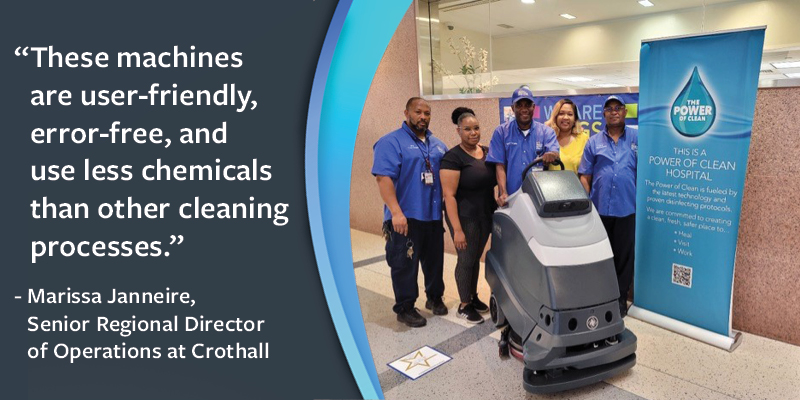One of them is named “Omega.” Another will be named in an upcoming hospital ceremony. They clean floors and are tireless workers. And they are helping New York City hospitals become more sustainable.
Robots are now cleaning the floors at four hospitals in the New York City Health + Hospital (NYCH+H) system. Beginning in March 2022, four autonomous robotic scrubbers began working at Kings County Hospital Center and Woodhull Hospital in Brooklyn, Bellevue Hospital in Manhattan, and Jacobi Medical Center in the Bronx.
According to Crothall Regional Director of Systems and Programs Paul Fratta, each robot can work two shifts, seven days a week throughout the hospital. For the leaders of NYCH+H, it is equally important that they clean floors in their “first-impression” lobbies, hallways, public spaces, elevator banks, clinics, and ORs. Because the public enjoys watching the robots at work, they often clean lobbies and other high-traffic areas during the busiest parts of the day.
“These machines are user-friendly, error-free, and use less chemicals than other cleaning processes,” says Marissa Janneire, Senior Regional Director of Operations at Crothall. “They make our facilities safe every day for patients in our community hospitals. That’s important; when people see a clean hospital, they are more likely to feel safer when coming here for their health care.”

The new machines aid the environment in two ways. First, they reduce the need for electricity with corded equipment. Next, by using an EPA-registered Safe Choice chemical, Medama® Super Shield, they clean floors using less chemicals.
Before the robots are put into use, a team from Nilfisk, the manufacturer, surveyed each hospital and developed a road map for the machine to operate independently.
Fratta goes on to explain that these diligent little “workers” are extremely efficient, controlling the amount of solution dispensed while the vacuum and drying tools work to minimize the “down time” of a wet floor that is still drying. In contrast, people that clean floors often apply too much chemical in an attempt to increase the product’s potency. However, there is often no benefit to this tactic, and it can also flood the floors, which increases the disposal of the chemicals into the drains/landfills and or water sources.
However, while the robots have several advantages, they do not replace frontline associates, according to Janneire. Instead, they become one more resource for Crothall to bring to augment a full staff’s efforts in cleaning and disinfecting an entire hospital each and every day. The machines are also available to help if COVID-19 or other contagious diseases re-emerge and fewer workers are available to work. By working two shifts each day, an automatic scrubber helps the entire workforce.
Janneire and her team also find that in addition to their sustainability and workforce benefits, the machines are also a fun and effective marketing tool for Crothall and the hospital. These autonomous workers, with their Power of Clean branding, attract a lot of attention and cachet by bringing a 21st century aura of error-free efficiency to the hospital experience.
“We want the public to see that we are using the best, safest technology to bring the Power of Clean to our hospitals,” Janneire says. “It really helps to influence the perception of clean and, in turn, has improved our HCAHPS scores!”



